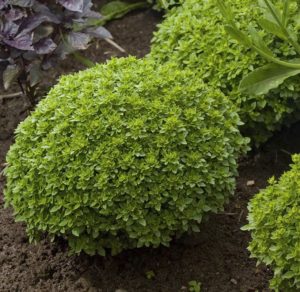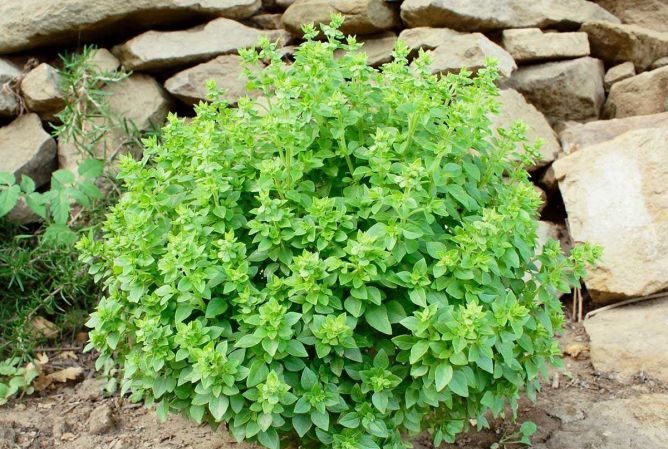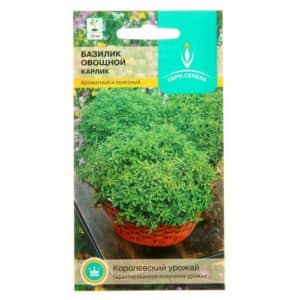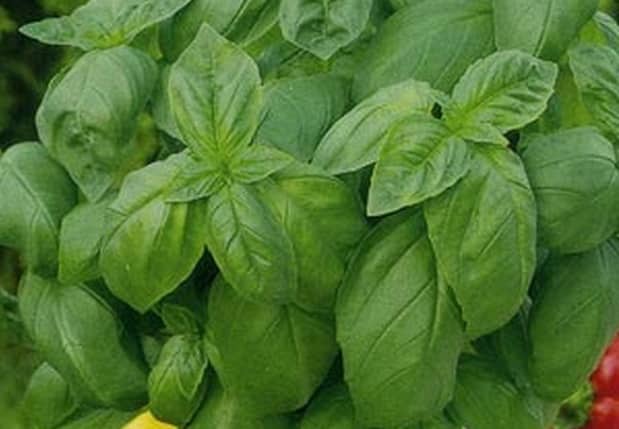What is good about the “Dwarf” basil variety: reviews from those who grew it, advantages and disadvantages
Basil Dwarf is not only a spice, but an ornamental plant. Every housewife can grow it on her windowsill, following simple planting and care rules. The article will tell you what its features and advantages are over other varieties and how to grow it correctly on your site in order to get a rich harvest of aromatic spice.
What type of basil is this?
Dwarf is a mid-early variety of basil. It has small rounded leaves with colors ranging from green to purple, small purple flowers. The full growing season from sowing seeds to harvesting is 55-60 days.
Brief history of origin and distribution
Basil became popular in Europe at the end of the 19th century. Previously, it was known only in the countries of the Middle East. For the first time in Europe, cooks from Greece, then Italy, and France began to use it. It is used to prepare seasonings and sauces for meat and fish dishes.
The plant reaches a height of no more than 35 cm - hence the name of the variety.
Fact! The dwarf was included in the State Register of Russia in 2006 and is recommended for cultivation on private farms.
Differences from other varieties

Main differences from other varieties:
- compact, low bush - grows in height from 10 to 35 cm;
- grown as an ornamental flower;
- It is distinguished by small leaves with a bluish-green color, collected in a spherical bush.
The yield of the variety ranges from 1.2 to 1.4 kg of greenery per 1 m².
Characteristics and description
The basil variety Dwarf has three varieties:
| Name | Description | Peculiarities |
|---|---|---|
| Dwarf green | Small bushes 10-18 cm high. The leaves are green, spherical in shape. | Has a clove-pepper aroma. |
| Greek dwarf | Bush 25-30 cm high. Green leaves, small in size. | Anise flavor and strong, persistent aroma. |
| Dwarf purple | The height of the bush is 30-35 cm. Small leaves with a purple color are collected in a neat bush. | Pronounced peppery aroma and taste. |
Features of the chemical composition
Basil leaves contain many micro- and macroelements beneficial to the human body:
- vitamin B2 – 0.076 mg;
- B4 – 4 mg;
- B5 – 0.209 mg;
- B6 – 0.155 mg;
- C – 18 mg;
- potassium – 295 mg;
- calcium – 177 mg;
- magnesium – 64 mg;
- phosphorus – 56 mg;
- iron – 3.17 mg;
- manganese – 1.148 mg.
Fresh basil leaves in a salad are a great tonic and improve digestion. 100 g of leaves contain 23 kcal, which allows them to be consumed by those who want to lose weight.
Basil contains:
- proteins – 3.15 g;
- fats – 0.64;
- carbohydrates – 1.05 g.
Durability
A distinctive characteristic of the Karlik variety is its resistance to diseases, for example, blackleg, gray rot, and fusarium. The plant tolerates heat (over +20...+25°C), but does not like drafts.
On a note! Does not tolerate sudden drops in air temperature.
Range of application of the variety

The Karlik variety has a clove-pepper, anise aroma and a peppery, spicy taste:
- used fresh for preparing salads, diet cocktails, and for canning;
- dried – as an additive to spices for meat, fish, first and second courses.
Found application in gardening and landscape design as an ornamental plant with purple flowers.Planted in open ground and in pots on the windowsill.
Read also:
Is it possible to plant basil before winter and how to do it?
Growing technology
To successfully grow dwarf basil at home, a number of conditions must be met:
- Monitor soil moisture and avoid overwatering. Excessive humidity provokes infection by parasites and the development of diseases.

- For basil, a ready-made fertile soil mixture with peat, which is sold in a specialized store, is suitable.
- The optimal temperature for growing the plant is +18…+25°C. If the temperature drops below +15°C, the basil slows down its growth. When it drops to +12°C, the spice completely loses its taste and dies.
- The light regime in summer is 16-17 hours. In autumn and winter, additional artificial lighting is provided.
- Pinching growing basil is done to increase the number of shoots and leaves.
Landing dates and rules
Sowing seeds for seedlings in prepared boxes or pots is carried out from April 10 to April 20. The depth of sowing seeds is no more than 1 cm.
- Furrows are made in the boxes at a distance of at least 5 cm from each other.
- Sow the seeds and sprinkle with soil.
- Water with a spray bottle.
At the beginning of summer (June 1-10) in central Russia, basil seedlings are planted in open ground. Planting pattern 20x30. Planting depth – 5-7 cm.
Important! The Dwarf basil variety loves sunny, open areas.
Further care
Basil is watered as the soil dries out. Use warm (+30°C) settled water. Sprouted seedlings are sprayed daily with water from a spray bottle.Young seedlings on the site need watering in hot weather 2 times a day - morning and evening.
Seedlings are fertilized once every 2 weeks:
- Mineral fertilizer is applied to the soil 10-14 days after planting for rooting and greenery.
- Infusion of cow or chicken manure - 0.5 liters per 10 liters of water.
- “Agrolife” – 1 tsp. per 1 sq. m of land.
Loosening and weeding are an important part of caring for basil. Loosening enriches the soil with oxygen and facilitates the penetration of air to the roots. Weeding prevents the appearance of weeds that stunt the growth of the plant.
On a note! A flowering basil bush is not suitable for eating, so pinch the top after the fourth leaf appears and trim the branches.
Possible problems, diseases, pests
Basil Dwarf is susceptible to diseases if one of the growing conditions is violated:
- Gray mold – appears from severe waterlogging of the soil. The plant withers and red spots appear on the leaves. Spray with infusion of onion peels - 100 g per 400 ml of boiled water, infuse for 24 hours.
- Fusarium - a dangerous fungal disease that kills the plant. The leaves turn yellow, the trunk becomes thinner, and the roots rot. For treatment, “Fitocid” and “Fitosporin-M” are used.
- Blackleg – affects young seedlings, the root stem rots, and occurs due to excessive watering. Treated with Alirin-B and Gamair.
Pests dangerous to basil are bugs and aphids. To combat them, a decoction of wormwood and tansy is used. Prepare at the rate of 1 liter of herbal infusion per 5 liters of water, sprayed 2-3 times a week. When spider mites appear, spray with Fitoverm.
Features of growing seeds/seedlings
Pre-sowing preparation of basil seeds involves heating and stimulating growth. 1-2 weeks before planting, place them in a warm place, for example, on a radiator. Then wrap it in damp gauze for a day so that the seeds wake up and hatch. Soak in the growth-stimulating solution "Epin" for 24 hours.
In the ground
It is not recommended to sow the Dwarf basil variety in open ground with seeds. To do this, use seedlings:
- The land for planting is fertilized in advance, organic fertilizer from leaf compost is applied, the area is dug up and cleared of weeds and rhizomes.
- Make holes 5-7 cm deep, plant seedlings at a distance of 10-15 cm from each other.
- Water with warm, settled water and sprinkle the roots of the plant with soil.
In the greenhouse
After 2 true leaves appear, basil seedlings are planted in a greenhouse. To do this, picks are made. Remove the root tip to allow the plant to develop strong lateral roots. Seeding pattern – 20x30 cm.
Caring for seedlings in a greenhouse:
- Daily spraying with a spray bottle and drip watering.
- Airing for 2-3 hours a day for hardening.
- Pinching the tops of basil to stimulate side shoots and foliage growth.
At home
Planting seeds at home is carried out in pots with prepared soil:
- The bottom of the pot should have drainage - pebbles, expanded clay or small stones.
- The pot is filled with soil, 4-5 cm short of the top, and moistened.
- Seeds are sown at a distance of 2-3 cm from each other, sprinkled with 1 cm of soil.
- Cover the pot with transparent glass or film to create a mini-greenhouse. Place in a warm place.
- With the appearance of the first shoots, the seedlings are provided with light, the greenhouse is opened and ventilated every day.
- After 10-14 days, the glass is removed.If necessary, thin out the seedlings.
Advantages and disadvantages of the variety

The main advantages of the Karlik variety:
- use as a seasoning for any dishes;
- a beautiful decorative flower that does not require complex care;
- its small stature allows it to be grown on the balcony, in a flower pot.
Disadvantage: early flowering. Therefore, you should constantly monitor the shoots and remove the flowers if you want to get leaves for seasoning.
Reviews from summer residents
To make sure that you have chosen the right variety, you should find out the opinions of those who have already grown it at home or on the plot.
Antonina, Dnepr: “I liked the basil variety Dwarf for its beauty, it grows in a small bush and does not require special care. This is the second year I have planted it in a flower pot. Always have fresh herbs on hand for seasoning.”
Svetlana, Syktyvkar: “We have cold winters, spring comes late, but we want something fresh, green. That’s why I grow Dwarf basil on the balcony along with parsley and dill. Small leaves, densely dotted on the branches, look very beautiful in my small greenhouse.”
Read also:
When to collect and how to properly dry basil.
Plant compatibility: what to plant basil next to and why it is important.
How to properly freeze basil for the winter: a selection of the best methods.
Conclusion
The vegetable basil variety Dwarf is excellent for growing at home. A small bush looks beautiful on the windowsill in the kitchen and delights the whole family with fresh herbs. Its ease of care, pleasant aroma and delicate taste have made it indispensable in preparing various dishes.